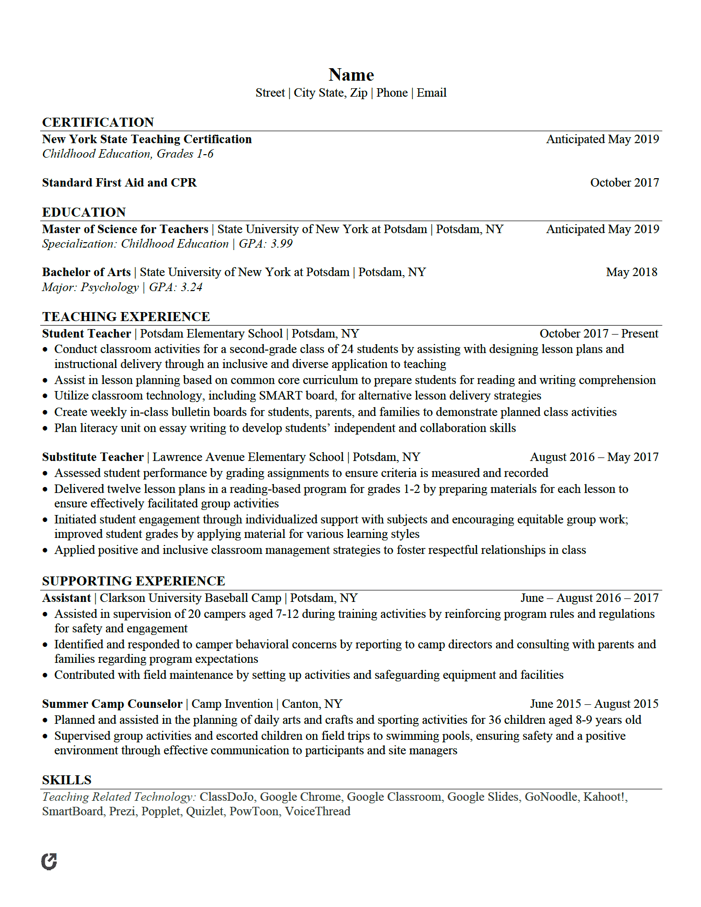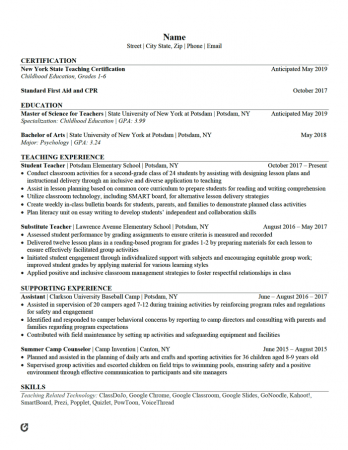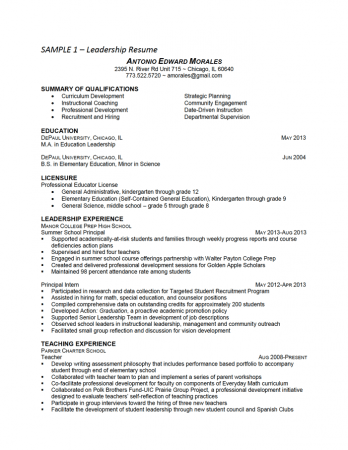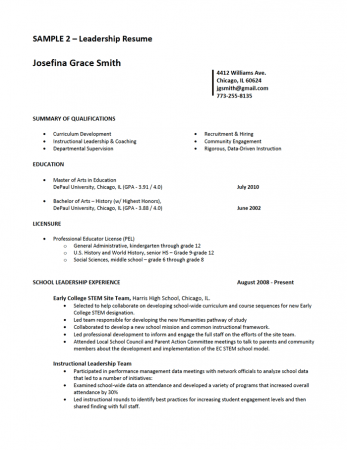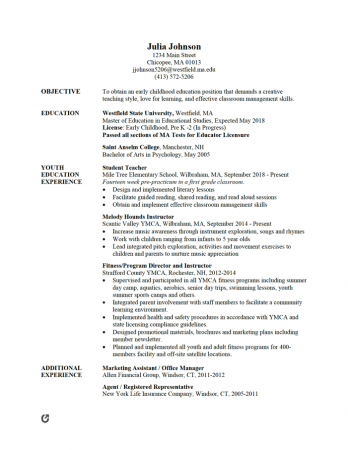Teacher Resumes
A teacher resume is a document that teachers use to highlight their skills and experience when applying for teaching jobs. It includes a teacher’s relevant education, certification, and work experience, as well as awards, accolades, or notable accomplishments. Some resumes may include a teaching philosophy, which can communicate a teachers’ attitude about education to potential employers. Despite slight variations between resumes, all templates highlight the teacher’s accomplishments and demonstrate their fitness for a job opening.
Table of Contents |
Teacher Resumes
How to Write a Teacher Resume
Writing a teacher resume is much like creating a resume for any other job, such as an accountant, marketer, or engineer. The most crucial sections are the opening statement and experience, emphasizing the teacher’s work ethic and overall educator goals. Employers look for ambitious teachers who have a strong desire to impact the world through education.
Follow the steps below to create a resume highlighting your best achievements and teaching qualities.
Step One – Compile Information
Include the most recent teaching positions, earned degree(s), and certifications. Consider how you can use this information to impress the person reading the resume. For example, if you had a 4.0 GPA, you might want to include those details, so the employer knows that you worked hard in college. Be sure to include each piece of information, even if it is a minor detail. Often, these points make your resume stand out from other candidates.
If an applicant has little-to-no teaching experience, consider including related work, such as tutoring, training, or coaching. Use precise wording that conveys what you did, learned, or achieved during that time. It may even be helpful to include anecdotes from students that you helped to show the employer that you make a difference in the lives of others through your work.
Step Two – Choose a Format
There are different ways to organize a teacher resume. A reverse-chronological format lists the most recent teaching jobs and completed degrees first, followed by the next most recent. This format is the standard and works well for teachers with several years of experience or if they’ve worked for a few different schools. A functional design spotlighting a teacher’s related skills and qualities may work best when beginning their career.
Step Three – Draft and Revise
Using a template or an original design, draft the resume. While keeping a resume to one or two pages is recommended, do not fixate too much on the word count. However, if your resume becomes three or four pages, consider ways to format it to make it as short as possible. For example, changing the margins, using single spacing, and smaller text can adjust the length of the resume.
Once it’s finished, go over it again to ensure it is free of errors, typos, or inconsistencies. Use spell check or software that gives you the best suggestions to make your resume sound professional and concise. Furthermore, making sure that the information is clear and organized shows that you care about the application and have a deep interest in taking on the role.
How to Put Teach For America on Your Resume?When putting Teach for America (TFA) on your resume, include the duration you were a member. Since recruiters may not know of TFA or its commitment requirements, clearly explain the role you took, along with any significant experiences that came with it. Participating in TFA can look especially good for candidates as it is not a requirement. It shows that you take the initiative to go beyond the day-to-day teaching role and feel dedicated to educating all people equally. Therefore, you may benefit from adding it to a visible part of your resume, such as in the top section. |
Teacher Resume Samples
Types of Teacher Resumes
Because teaching jobs range from substitute teachers to university instructors, there are several types of teacher resumes. Each type frames information specifically for its corresponding teaching job.
Teaching Assistant
Teaching assistants (sometimes called paraprofessionals) work alongside a teacher in a classroom, often in elementary school or special education settings. This type of resume highlights the teaching assistant’s role by providing information about their impact on classroom management and learning outcomes. For instance, a teaching assistant’s resume may include specific interventions they used. It also allows teachers to highlight their proudest accomplishments, such as leading a reading group where the children jumped two reading levels in one year.
Substitute
Because a substitute teacher’s job is versatile and flexible by nature, the substitute teacher resume is no different. This resume highlights the variety in work and communicates effective strategies the substitute uses on the job. A substitute might write on their resume that they “increased student participation to 100%” during a long-term contract.”
Pre-K and Kindergarten
This resume emphasizes a teacher’s knowledge and skills in early child development and classroom management. Providing snapshots of a teacher’s skills and accomplishments, such as “adept at positive reinforcement strategies” or “prepared in-depth progress notes for 25 students each quarter,” appeals to principals or other hiring personnel.
Elementary and Middle School
On this type of resume, elementary and middle school teachers spotlight their achievements in teaching and classroom management strategies and work outside of the classroom. For instance, this type of resume might include the number of field trips the teacher planned and directed, the growth percentage in math scores, or technology implementation into lessons and projects.
High School
Due to the increased rigor of the high school curriculum, this resume shines best when it presents teacher impact, student outcomes, and specialized experience. A high school teacher’s resume may include “designed and developed original curriculum map for Honors Chemistry” or “Increased participation and retention in a zero-hour academic lab.” More than a listing of daily tasks, this resume catches an employer’s eye when demonstrating a teacher’s effect.
Post-Secondary
In higher education, teacher resumes may take the form of a CV (curriculum vitae). This document is typically longer than the standard one-page resume. It details courses taught, publications, presentations, research studies, and other work in academia.
Teacher Resume Templates
How to Make a Teacher Resume Stand Out
There are various skills, responsibilities, and outcomes in a teacher’s day-to-day and throughout their career. Organizing this information clearly and effectively can help it stand out and win interview opportunities.
Create a Strong Opening Statement
Typically, resumes start with an opening statement explaining an applicant’s career objectives. This section can include teaching philosophy, specializations, and other career highlights. An effective statement captures the teacher’s strengths and demonstrates their fitness for the job.
For example, a strong opening statement can read: “Passionate STEM teacher with 5+ years experience in project-based learning, flipped classrooms, and 1:1 technology integration. Responsible for 30% growth in math test scores and rated Highly Accomplished in evaluations.”
Add Unique Skills
Most people – especially principals or other hiring personnel – know what a teacher does daily. Instead of putting tasks, such as “graded weekly math tests” or “planned and delivered lessons to 80 students per day,” articulate the teacher’s skills’ impact, outcome, or effect. Here are some examples:
- Averaged over 85% pass rate for the AP English Literature exam in all four years.
- Implemented a school-wide social-emotional learning curriculum that reduced the number of in-school suspensions by 40%.
- Coached the Speech and Debate team to win their first State Championship.
- Won Teacher of the Year in 2014.
Include Specialties
Some teachers may have specialties, such as national board certification, membership in professional teaching associations, unique work experience (such as Teach for America or teaching abroad). Some teachers find additional responsibilities, such as mentoring student teachers, coordinating after-school programs, or delivering professional development.
All of these specializations can make an applicant stand out. They tell a principal that the teacher is well-rounded, has developed expertise, and can offer more than the typical daily teaching duties.
Here are some examples of how to write specialties on a teacher resume:
- Scored Highly Effective in student-teacher evaluation by a teacher mentor
- Taught English to students in Taiwan and raised language proficiency by 30%
- Presented about digital literacy at state and national conferences
- National Board Certified in Music Education
How to Add Coaching to Teaching ResumeAdding coaching experience to your resume tells recruiters that you genuinely care about education and helping individuals improve their learning skills. Coaches are generally empathetic people who have a knack for teaching one-on-one. Furthermore, teachers may coach on the side, showing their passion for spreading education to all. Job recruiters are more likely to hire candidates who exhibit this type of enthusiasm outside the classroom. The best area to add coaching to your teaching resume is in the “Experience” section. |
Teacher Resume Examples
Key Takeaways
When writing a teacher resume, present the outcome and impact of a teacher’s work, rather than merely listing tasks. Principals want to see how well a teacher will fit into their school’s culture, meet the needs of their student body, and influence potential colleagues. A principal can discern all of these from a strong resume that includes a teaching philosophy or career objective, describes qualifications, and articulates results.
